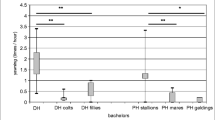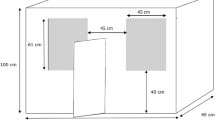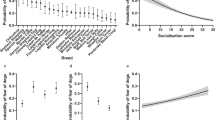Abstract
This study was undertaken to investigate factors associated with stereotypic behavior in stabled horses in Iran. We evaluated sex, age, breed, color, frequency of feeding in the day, social contact with other horses during stabling, and the design of stable. We divided the stable design into two groups: indoor stables and those where the horses had contact with the outside environment. No statistical relationship could be found between the factors examined and stereotypic behavior. However, we found trends relating age group (1–7 and >7 years), color (white and dun were over-represented), breed (Thoroughbred and Arabian horses were over-represented), and daily feeding frequency (twice over-represented compared with three times). Horses with tactile contact with others showed less stereotypy than those that had no tactile contact with neighbors. This study suggested that the most important factors in the occurrence of stereotypic behavior are social interaction with other horses and frequency of feeding. Stereotypies appear to be related to management factors.
Similar content being viewed by others
References
Broom DM, Kennedy MJ (1993) Stereotypies in horses: their relation to welfare and causation. Equine Vet Educ 5:151–154
Clegg HA, Buckley P, Friend MA, McGreevy PD (2008) The ethological and physiological characteristics of cribbing and weaving horses. Appl Anim Behav Sci 109:68–76
Cooper JJ, Albentosa MJ (2005) Behavioural adaptation in the domestic horse: potential role of apparently abnormal responses including stereotypic behaviour. Livest Prod Sci 92:177–182
Cooper JJ, Mason GJ (1998) The identification of abnormal behaviour and behavioural problems in stabled horses and their relationship to horse welfare: a comparative review. Equine Vet J Suppl 27:5–9
Cooper J, McGreevy P (2007) Stereotypic behaviour in the stabled horse: causes, effects and prevention without compromising horse welfare. In: Waran N (ed) The welfare of horses. Springer Publication, Dordrecht, pp 99–124
Cooper JJ, McDonald L, Mills DS (2000) The effect of increasing visual horizons on stereotypic weaving: implications for the social housing of stabled horses. Appl Anim Behav Sci 69:67–83
Johnson KG, Tyrrell JB, Rowe JB, Pethick DW (1998) Behavioural changes in stabled horses given nontherapeutic levels of virginiamycin. Equine Vet J 30:139–143
Kiley-Worthington M (1987) The Behaviour of Horses in Relation to Management and Training. JA Allen, London, UK
Mason GJ (1991) Stereotypies: a critical review. Anim Behav 41:1015–1037
McGreevy PD (1999) Eight case reports of crib-biting foals. Equine Vet J Suppl 28:66
McGreevy PD, Cripps PJ, French NP, Green LE, Nicol CJ (1995a) Management factors associated with stereotypic and redirected behaviour in the Thoroughbred horse. Equine Vet J 27:86–91
McGreevy PD, French NP, Nicol CJ (1995b) The prevalence of abnormal behaviours in dressage, eventing and endurance horses in relation to stabling. Vet Rec 137:36–37
Mench JA, Mason GJ (1997) Behaviour. In: Appleby MC, Hughes BO (eds) Animal Welfare. CABI Publishing, Wallingford, UK, pp 127–141
Mills DS, Alston RD, Rogers V, Longford NT (2002) Factors associated with the prevalence of stereotypic behaviour amongst Thoroughbred horses passing through auctioneer sales. Appl Anim Behav Sci 78:115–124
Nagy K, Schrott A, Kabai P (2008) Possible influence of neighbors on stereotypic behaviour in horses. Appl Anim Behav Sci 111:321–328
Nicol CJ, Davidson HP, Harris PA, Waters AJ, Wilson AD (2002) Study of crib-biting and gastric inflammation and ulceration in young horses. Vet Rec 151:658–662
Nicole, CJ (1999) Stereotypic and their relation to management. In: Proceedings of the British Equine Veterinary Association Specialist Days on Behaviour and Nutrition, Ed: Harris, PA, Gomarsall, GM, Davidson, HPB, Green, RE pp. 11–14
Ninomiya S, Sato S, Kusunose R, Mitumasu T, Obara Y (2007a) A note on a behavioural indicator of satisfaction in stabled horses. Appl Anim Behav Sci 106:184–189
Ninomiya S, Sato S, Sugawara K (2007b) Weaving in stabled horses and its relationship to other behavioural traits. Appl Anim Behav Sci 106:134–143
Radostits OM, Gay CC, Hinchcliff KW, Constable PD (2007) Diseases of alimentary tract-I. Veterinary medicine, 10th edn. Saunders Elsevier, Edinburgh, p 242
Redbo I, Redbo-Torstensson P, Odberg FO, Hedendahl A, Holm J (1998) Factors affecting behavioural disturbances in race-horses. Anim Sci 66:475–481
Sarrafchi A, Blokhuis H (2013) Equine stereotypic behaviors: causation, occurrence, and prevention. J Vet Behavior 8:386–394
Sondergaard E, Jensen MB, Nicole CJ (2011) Motivation for social contact in horses measured by operant conditioning. Appl Anim Behav Sci 132:131–137
Waters AJ, Nicol CJ, French NP (2002) Factors influencing the development of stereotypic and redirected behaviours in young horses: findings of a four year prospective epidemiological study. Equine Vet J 34:572–579
Whisher L, Raum M, Pina L, Perez L, Erb H, Houpt C, Houpt K (2011) Effects of environmental factors on cribbing activity by horses. Appl Anim Behav Sci 135:63–69
Wickens CA, Heleski CR (2010) Crib-biting behavior in horses: a review. Appl Anim Behav Sci 128:1–9
Acknowledgements
We are grateful to owners and staff of horse riding institutions who helped facilitate this study.
Author information
Authors and Affiliations
Corresponding author
Rights and permissions
About this article
Cite this article
Dezfouli, M.M., Tavanaeimanesh, H., Naghadeh, B.D. et al. Factors associated with stereotypic behavior in Iranian stabled horses. Comp Clin Pathol 23, 1651–1657 (2014). https://doi.org/10.1007/s00580-013-1840-3
Received:
Accepted:
Published:
Issue Date:
DOI: https://doi.org/10.1007/s00580-013-1840-3




